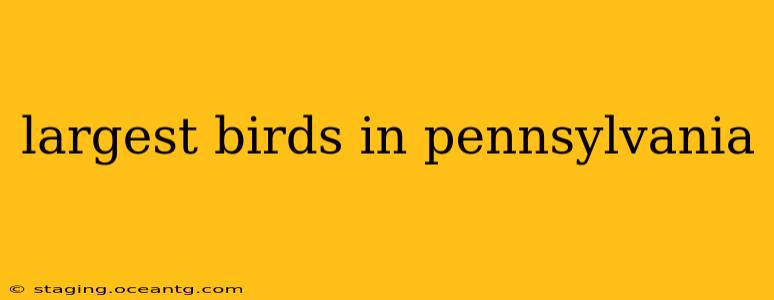Pennsylvania, with its diverse habitats ranging from forests and mountains to wetlands and farmland, is home to a fascinating array of bird species. While many are small and easily overlooked, some truly impressive avian giants call the Keystone State home. This guide explores the largest birds found in Pennsylvania, examining their characteristics, habitats, and the best places to spot them.
What are the Largest Birds in Pennsylvania?
Determining the "largest" can be tricky, as we could consider weight, wingspan, or overall length. However, some consistently rank among the largest birds regularly sighted in Pennsylvania:
-
Wild Turkey (Meleagris gallopavo): These iconic birds are instantly recognizable thanks to their distinctive plumage. Males, or gobblers, are significantly larger than females, with adult males often exceeding 10 pounds and boasting a wingspan up to 6 feet. They are widespread throughout the state, inhabiting forests and open woodlands.
-
Great Blue Heron (Ardea herodias): A majestic wading bird, the Great Blue Heron is a common sight near bodies of water. Standing tall at up to 4 feet and with a wingspan approaching 6 feet, it's a commanding presence. They feed on fish, frogs, and other aquatic creatures in marshes, rivers, and lakes.
-
Canada Goose (Branta canadensis): While perhaps not as visually striking as the turkey or heron, Canada Geese are large and abundant in Pennsylvania. Adults can reach up to 10 pounds and have a wingspan of over 6 feet. They are often seen in large flocks near water, parks, and fields.
-
Bald Eagle (Haliaeetus leucocephalus): A national symbol, the Bald Eagle is a magnificent sight. While not the heaviest, their impressive wingspan (up to 7 feet) and overall size make them one of the largest birds in Pennsylvania. They primarily inhabit areas near large bodies of water with ample fish populations.
What is the Heaviest Bird in Pennsylvania?
The Wild Turkey generally holds the title for the heaviest bird regularly found in Pennsylvania. Mature male turkeys can significantly outweigh even large Canada Geese. However, it's important to note that weight can vary considerably depending on the individual bird, its age, and the time of year.
Where Can I See the Largest Birds in Pennsylvania?
The best places to spot these avian giants depend on the species:
-
Wild Turkeys: State parks and forests throughout Pennsylvania offer good chances of spotting wild turkeys, particularly in areas with oak and hickory trees, which provide them with food and cover.
-
Great Blue Herons: Look for them near lakes, rivers, marshes, and other wetlands. Many state parks and wildlife refuges provide excellent viewing opportunities.
-
Canada Geese: These birds are ubiquitous near water sources across the state, from city parks to rural ponds.
-
Bald Eagles: Designated wildlife areas and refuges that offer prime eagle-viewing locations are scattered across Pennsylvania. Checking with the Pennsylvania Game Commission for current information on eagle nesting sites is highly recommended.
What are some of the other large birds in Pennsylvania?
While the aforementioned birds are consistently among the largest, other large species that can be found, although perhaps less frequently or in smaller sizes than the others listed, include:
- Sandhill Crane: A tall and graceful bird with a long neck and legs.
- Whooping Crane: While rarely seen in Pennsylvania, these majestic birds are the tallest in North America.
Remember to always practice responsible birdwatching etiquette – maintain a safe distance, avoid disturbing their habitats, and use binoculars to observe them without causing stress.
What are the biggest birds of prey in Pennsylvania?
The Bald Eagle is certainly one of the largest birds of prey in Pennsylvania, with the Red-tailed Hawk also being a considerable size.
By understanding the characteristics and habitats of these magnificent creatures, you can increase your chances of spotting Pennsylvania's largest birds and appreciating the rich biodiversity of the Keystone State. Remember to respect their natural environment and enjoy the incredible spectacle of these avian giants.
